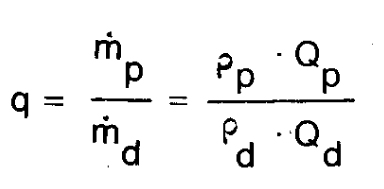3.5.1 Jet pump
Jet pump
Jet pump or an injector pump operate by converting the surplus impulse energy of a driving jet directly to the pumped medium without the assistance of moving mechanical components. The motive medium can be a gas like air for example, or steam or a liquid like water. There are different combinations of motive for pumped media. The most usual are water steam for air, water steam for water, water for air and water for water.

Figure 3.51a Diagrammatic principles of a Jet pump
By applying the momentum equation to a control volume, which precisely surrounds the medium in the mixing tube:

or

Certain characteristics of jet pumps can be learned by studying the equation 3.51b. In order that the pressure P6 shall be greater than P4 then the velocity leaving the jet nozzle c4 must be considerably larger than c6 and c5. Considerable mixing losses are therefore also unavoidable. Pressure increase is greatest when ṁp= 0. The shear stresses at the wall of the mixing tube have a tendency to reduce the pressure increase. A diffuser (venturi) is mounted after the mixing tube where velocity is reduced and static pressure increases. The relationship between the pumped mass flow ṁp and the motive fluid mass flow ṁd is called the flow coefficient and is designated:

The pressure relationship for a jet pump can further be defined as:

Using these designations, jet pump efficiency can be expressed as:
η =q * z

Figure 3.51b Performance curves for a jet pump.
Jet pump losses consist of flow losses in the nozzle, intake chamber, mixing tube and diffuser (venturi). The mixing losses constituting the greatest loss. Mixing losses are primarily dependent upon the area relationship:

For each combination of pressure relationship z and flow relationship q there is an optimum area relationship a see figure 3.51c.

Figure 3.51c Performance curves for an oil-jet pump for various area relationships (a).
Other important design parameters are the distance between the mouth of the nozzle and the start of the mixing tube; the length of the mixing tube and the angle of the diffuser (venturi).
The lowest pressure in a fluid-jet pump occurs in the upstream section of the mixing tube. If the lowest pressure reaches the liquid’s vapour pressure then cavitation will occur. The cavitation number is defined as:
Pv = vapour pressure
P1&2 = total pressure at that point
If for a given jet pump P2 is reduced at the same time as P1 and P3 are adjusted so that the pressure relationship z is maintained constant, the cavitation number σ will reduce without initially changing the value of q and η. Further reduction of P2 causes successively more cavitation in the mixing tube and a rapid fall-off in efficiency. This value of cavitation number is designated σk.

Figure 3.51d Cavitation in fluid-jet pumps.
Another way of illustrating the onset of cavitation in a fluid-jet pump is that at constant motive pressure and back-pressure (P1 and P3 respectively) reduces P2. The
pumps optimum operating point will then follow down the performance curve – z increases, q and σ reduce. For σ > σk the pump operates without the effects of cavitation being noticeable. At σ = σk the performance is reduced in relation to the cavitation-free operation. Prolonged operation where cavitation is present can cause damage to the mixing tube and the diffuser (venturi). Jet pumps have certain fundamental advantages:
- No moving parts, no lubrication requirements
- No sealing problems
- Self-priming (can evacuate the suction line)
- No electrical drive no risk of explosion
The most obvious disadvantage is the low efficiency. Maximum efficiency being 25-30%.
Steam-jet pumps are normally used for or in order to achieve, low pressure at the inlet side. For inlet pressures of down to 10³ Pa -absolute pressure- water steam is generally used as the motive medium. For even lower pressures, down to hundredths Pa, oil steam is used as the motive medium.
Practical examples: De-airing condensers, evacuating flammable gases, fluid transportation coupled with simultaneous heating requirements. Compressed air is often available and is the most usual motive medium for gas-jet pumps. Some common practical examples of fluid-jet pumps, usually using water as the motive medium, are illustrated in figure 3.51e.
Figure 3.51d Water-jet pumps practical application examples.
Especially advantageous use can be made of jet pumps if a requirement to mix the various combinations of motive and pumped fluid can simultaneously be fulfilled. Examples of this are steam-jet pumps used in ventilation systems where simultaneous humidifying is required and liquid-jet pumps for transporting liquids which require simultaneous dilution.


